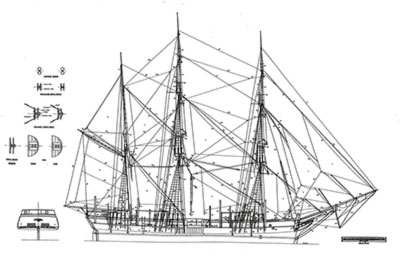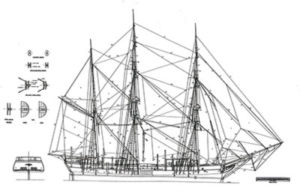“Screw the past!”

Those were my words—approximately—as I abandoned my effort to sleep like a nineteenth-century whaleman. After three claustrophobic hours, I slid from my small, high bunk and managed to avoid stepping on the head of the occupant of the berth beneath. I climbed a ladder to the deck and inhaled the cool air. Screw the past.
It had been a pale attempt to begin with. Although I was sleeping in the mariners’ actual quarters, they were free of the vermin that had cohabited with the sailors of yore. And the ship was not rolling in the ocean, either. It was tethered snugly to a pier in the Charlestown Navy Yard. I spent the rest of the night sleeping on a bench on deck. Every now and again I opened an eye to take in the glittering Boston skyline.
The place where whalemen slept was known as the forecastle. It was usually abbreviated as foc’s’le, which is pronounced something like “foxhole,” and other things. “Foc’s’le” very appropriately undercuts any sense of grandeur that the term “forecastle” might possess. In its design and dimensions, the fo’c’sle reflected shipbuilders’ intuitive understanding of just how little space and air a human being at repose could be granted without compromising his ability to perform heavy labor at a moment’s notice.
The reason for stinting on the whalemen’s accommodation was not spite—although one imagines that if contempt were not present at the outset, the owners and shipbuilders must have had to conjure some as justification. In truth, whalemen just had to make room for the commodities that were the ship’s raison d’être: blubber, baleen, and oil. Sailors were squeezed on the ship so that back on shore lamps could be lit, machines lubricated, and women dressed in skirts shaped like the Capitol dome.
Besides, sailors were not really supposed to sleep. They were supposed to work. And it is in seeing them work that one truly begins to appreciate the whaleship as an intricately calibrated wood, rope, and canvas machine. I had previously visited tall ships at dock, but it was quite a different thing to observe a ship under sail (and to help pull the occasional rope). This machine’s motive force is wind and currents, but its operation depends on two dozen people synchronously crawling, climbing, pulling, hanging, jumping, and swinging. When the first mate shouts “On the fore topmast stays’l, tend the sheets, cast off the downhaul, haul away on the halyard,” the sailors repeat the command, some grabbing ropes and others scurrying up the rigging. They reminded me of a circus troupe. Those aloft then shimmied along ropes, more than eighty feet in the air, tying and untying sails. They also reminded me of steelworkers raising a skyscraper. Native Americans were prominent in whaling in the nineteenth century and steelworking in the twentieth; was there a connection? Certainly the warrior ethos, with its mix of daring and distance from home, united them both.
I wondered who today’s sailors were, where they had learned their craft, and why. The sailors of tall ships are a special lot. They are self-professed “outliers,” “misfits,” “gypsies.” When Tony Horwitz followed up Confederates in the Attic with a book about a tall ship, he was reaching for low-hanging fruit. Here was another group of people born in the twentieth century who were making the nineteenth their home. However, unlike Horwitz’s Civil War re-enactors, none of the Charles W.Morgan‘s crew are hobbyists. They are more highly skilled and professionally trained. Many come through the Navy, Coast Guard and maritime academies, and have advanced degrees in marine sciences and related fields.
Like Melville’s Ishmael, today’s tall-ship sailors are possessed of a certain misanthropy. They treat this condition with a strong dose of the strenuous life. Out of sorts on land, deckhand Joee Patterson said that she and her shipmates take solace in the routine of “hard work, long days, exposure to the elements, and each other.” She believes that this connects her with sailors of the past. (It at least explains how anyone sleeps, or slept, in the forecastle.) In the words of Dana Mancinelli, another deckhand, the appeal is “Neverlandish.” The ship is the “world of pine tar, bow sprits, forecastles, royal yards, moon rakers, cat tackles, gypsy heads, black powder, and clear horizon.” Put that way, the tall-ship life does seem to beat office parks, strip malls, and interstates. Joee and Dana articulate some of the same reasons for shipping out as whalemen in the past—minus dire economic need.

But they also differ from whalemen of the past because they are women, as are a surprising number of hands on today’s tall ships. They testify to women’s ability to handle the same tasks as men and to forge a place in traditionally male occupations—especially low-paid ones, of course. The Morgan‘s second mate, Sean Bercaw, explained his preference for women officers and hands. “Generally,” Bercaw observed, “women are more cognizant of their abilities; if they say they understand, they do, and if they don’t they’ll let you know.”
Getting things right matters, both for the ship and the future of sail-craft. This cadre of skilled individuals, fluent in the arcane language of the tall ship, represents a thin line of knowledge transmission. They are akin to practitioners of antique musical instruments whose proper use will be lost if that line is broken. Even on a vessel as large as the 113-foot-long Morgan, sailing involves a strong element of touch. When the command is given to “Let the leech luff,” the crew is being told to keep the wind so it fills the sail with a slight flutter on the leeward edge. Those sails are manipulated via miles of rope criss-crossing the masts and yards. The ship functions a little like an orchestra; every voyage is a performance, and an interpretation.
But let’s not forget what ships like the Morgan were built to do: hunt and kill whales. Sitting squarely on the main deck behind the foremast are the ship’s tryworks. The tryworks are a large rectangular brick oven crowned with a pair of not-quite-circular metal cauldrons that make it look like a giant electrical outlet. On our voyage, the tryworks received little attention. They served mostly as a shady place to store water bottles. But historically, the tryworks represented the very heart of the whaleship. They were used to render the whale blubber into oil, in which form it was more readily stored and marketed. Having the means of processing blubber on the boat itself turned the vessel into a floating factory—and an olfactory nightmare. Melville described the smell of the blazing tryworks quite memorably (and un-toppably) as “the left wing of the day of judgment.” Shipboard tryworks made whaling more profitable, more efficient, and hence more intense. The tryworks helped usher in the industrial age.

The Morgan was, and is, a fine sailing ship. It was also a floating slaughterhouse. It was part of an armada of ships that created America’s first oil boom, one in which the oil was extracted from the heads of whales. In pursuing this precious commodity with abandon, they devastated whale populations in all the world’s oceans. The Morgan is a testament to human ingenuity, but also to its remarkable destructive capacity—even when only wind, currents and a little human muscle could be called to muster.
Like an antebellum plantation with its Big House, fields, and slave quarters, the whaleship challenges us to choose or combine perspectives on its story. The temptation is, of course, to dwell on the elegant: in this case, the fine craftsmanship of the vessel, or the majestic vista from the crow’s nest. Even having climbed only part way up the rigging, I won’t forget that view from on high anytime soon: 360 degrees of water, sunlight, and distant shoreline. Unaccustomed to heights, the one direction in which I did not look was down. Had I so dared, I would have seen the tryworks and the hatches leading below deck—places from which the Morgan’s story looks very different. My unpleasant hours in the forecastle, screw-the-past moment included, had not been in vain. They immunized me against an idealized sense of shipboard life, and highlighted the extraordinary range in the life of the nineteenth-century whaleman. His day encompassed the exhilaration of the crow’s nest, the suffocation of the forecastle and the tryworks, and remarkable hard work in between.
This article originally appeared in issue 15.1 (Fall, 2014).
Karim Tiro is chair of the history department at Xavier University in Cincinnati, Ohio. He is author of The People of the Standing Stone: The Oneida Nation from the Revolution through the Era of Removal and co-editor of Along the Hudson and Mohawk: the 1790 Journey of Count Paolo Andreani.
